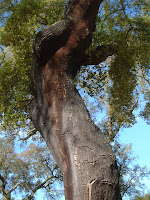I talk (or think) about cork all day, every day. I have for years. Explaining the process of the cork harvest and how the bark immediately begins to re-generate has always made me feel good. The key points are:
- The tree is not cut down in the harvesting process.
- The tree will naturally live to be 200 and 500 years old.
- The bark can be harvested every nine years on average during the tree's life.
What a fantastic process! A fully sustainable natural material.
Why then, over the past few years, have people started telling me that we should stop selling cork due to "a shortage"? At the Green Living Show in Toronto, I talked to hundreds of people and time-and-again; the question was the same: "isn't cork going extinct?" Some were outright hostile, accusing us of destroying the environment by promoting cork. I was waiting for picket signs to appear, asking for a cork boycott.
In fact...
The reality is quite the opposite. The environment will only be hurt by cork not being used.
This truth goes back to the fact that cork is a renewable resource. The cork trees from which the product is harvested are not cut down. If the world does boycott cork, we will see severe repercussions both in the environment and in the cork growing regions' economy. Cork is the lifeblood for many areas in the Mediterranean. If cork is not being used, then farmers will be forced to cut down the trees to plant a more profitable crop or even sell the land to be developed.
Currently, cork trees cover immense land areas in the Mediterranean region. They are the second most diverse ecosystem in the world behind the Amazon Rainforest. Even better, it is estimated that the forests retain up to 14 million tons of CO2 each year.
The World Wildlife Fund says that "cork oak forests support one of the highest levels of biodiversity among forest habitats, as well as the highest diversity of plants found anywhere in the world." [1]
Why the myth?:
Winemakers started using synthetic corks as well as screw caps in the 1990s. Some of this occurred at a time when there were forest fires in Portugal. Although forest fires are a natural part of any ecosystem, combining these two situations propagated a myth that there was a cork shortage.
I believe that winemakers initially began using synthetic wine corks to reduce the incidence of cork taste that occasionally occurs in wines. Curiously, studies show that "cork taint" is still occurring despite the use of synthetic stoppers and screw caps. That means that it's coming from elsewhere[2].
As consumer acceptance of synthetic stoppers began to take hold, winemakers decided to take it a step further and add product cost reduction to the mix. Thus the introduction of screw-cap wine bottles. Screw-caps became a household reality. Screw-caps are made from a metal top and plastic liner – a very synthetic alternative to a natural product. I find this ironic since most other industries are at least attempting to use more natural product packaging.
Before 1990, nearly every wine bottle was closed with real cork. Since the wine bottle's innovation, natural cork has been used to close billions of wine bottles. Yet now, despite society's awareness of threats to the environment, we are rejecting nature.
As winemakers continue to embrace synthetic closures and screw caps, the myth of a cork shortage or extinction continues to be propagated. Cork forests continue to be vibrant but face a threat. The solution to this threat is to use products made from cork. Using cork, you help preserve the most diverse and vital habitat and make the world a better place in which to live.
Permission to reprint provided the author is credited and notified.
More information:
Update: September 2020
In the last few years, we have seen a push back to the synthetic cork or screw-cap option for high-end wines. Many top winemakers now swear that natural cork improves their taste in the long run by allowing it to age while in the bottle. This development gives hope that this historic and vital industry will continue for many generations.



